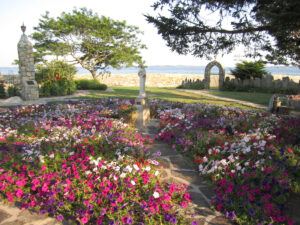When curious non-Catholic Christians ask what the essential difference is between Catholics and Protestants, I tell them this: Catholics have retained something all people once had: “the sacramental vision” which is the conviction that God is not separate from the world he created, but that he works in and through the material, physical order.
The Incarnation itself is the great example of God’s working in this way. This sacramental vision is made particular in the seven sacraments, but this vision of reality extends to the sacramentals and to a more general understanding of the world as expressed in the full range of the arts. Liturgy, I explain, is a compendium of culture. The celebration of the liturgy is not simply the particular sacrament being celebrated, but it includes the whole action, locale and context of the Mass. It includes the architecture, mosaics, sculpture, frescoes, stained glass, vestments, music, story and saga, parables and poetry from Scripture and gathers all of this in one action of Christ in his Church.
In his new book The Forgotten Language, Father Michael Rennier emphasizes this same insight: the need for a poetic vision to re-vitalize the celebration of the Mass. He makes his case via a highly personal argument for a more poetic understanding of life which, in turn, deepens the transcendent appreciation of the Mass both for the celebrant and the faithful.
Drawing from his own experience as a father and priest (like me he is a married former Anglican ordained under the Pastoral Provision) Rennier weaves his conversion story and love of poetry into his plea for a more beautiful and reverent celebration of the Mass. I would have liked the addition of a more objective argument. And yet the personal perspective carries a great deal of power.
The current liturgy wars in the church are often reduced to traditionalist-minded Catholics lamenting the often banal and sometimes brutal liturgical abuses allowed by the flexibility of the Novus Ordo Mass. Traditionalists who call for “more reverence” too often focus their pleas merely on the externals. “If only everyone would receive communion kneeling and on the tongue!” “If only Mass were celebrated ad orientem!” “If only we brought back altar rails, got rid of girl altar servers, had more incense…whatever.”
Yes, externals matter, but Rennier’s book calls for more than the introduction of externals. Instead he inspires reverence through a deeper appreciation of the poetic vision (what I term the sacramental vision) that lies at the heart of Catholicism.
The malaise within the Church evidenced by the banal liturgies is really rooted in a much deeper disease—a widespread modernism that has infected catechesis and formation at every level of the contemporary church. To state my own thesis bluntly and briefly: Liturgy in the Catholic Church is shallow, superficial and sentimental because the faith we believe has been watered down with sentimentalism, materialism and modernism.
A robust and reverent liturgy is the expression of a robust and reverent faith. That robust, radical religion is rooted in an uncompromising adherence to the historic Christian creed, faithful to the Sacred Scriptures and the magisterium of the Catholic Church. This deep faith produces solid, robust, traditional Catholic worship. Merely implementing traditional externals are not enough.
Rennier received his robust and reverent faith in Christ from his non-Catholic foundation. He is a product of Evangelical fundamentalism who found his way through Anglicanism to the Catholic Church and eventually the Catholic priesthood. I found his pilgrim progress from Oral Roberts University through Yale Divinity School and liberal Anglicanism to echo my own journey from Bob Jones University to Oxford and the Church of England. Both of us were captivated by the poetic and sacramental vision, missing in evangelical culture, that was first made accessible through Anglicanism, then fulfilled in Catholicism.
Having come home to the Catholic Church, both of us were disappointed by the lack of understanding and appreciation of the wealth of Catholic tradition in modern American Catholicism. Inspired by the riches of the sacramental/poetic vision expressed in the Anglican Church, we were dismayed to experience the banal music, brutal architecture and liturgical incompetence and ignorance in much contemporary Catholic worship.
Both of us, however, eschew the fey aestheticism too often present within high church Anglicanism and too often found as well within traditionalist Catholic circles.
Truly reverent and bautiful Catholic worship should also be accessible to ordinary folks on a limited budget. Beauty does not have to be elitist.
Perhaps it is our condition as married men that makes us perceive this truth. Rennier’s plea for a return to the poetics of the Mass is rooted in a poetic vision of his ordinary life as a husband and father. This may be a challenging proposal for Catholic traditionalists, but one which needs more thought and discussion: How does a faithful Catholic home life enrich and enable a more poetic, reverent and beautiful liturgical life and how might this interaction include married Catholic priests we now have and their wives and families?
Rennier does not offer a detailed blueprint for the renewal of liturgy in our age. I came away from this heartfelt book grateful for the personal insights, but hungry for more particular advice: How should a parish priest move the celebration from the banal to the beautiful? How does one navigate the pastoral and professional obstacles to a more reverent liturgy? What can the people in the pew do to ensure more reverence and deeper praise? How should seminaries form priests in the poetic vision in a non-poetic age? If the Traditional Latin Mass is now to be marginalized, how best can the celebration of the Novus Ordo be informed by the beauties of the Traditional Latin Mass? How does a priest undo the abuses of his predecessor and establish a sure foundation for reverent worship—even if he should be moved to another parish? All of these questions and more should be part of a larger discussion for parish people and priests as we seek to renew the liturgy in the true spirit of the second Vatican Council.
This is a rich discussion worthy of a book of its own. Let me here offer a few insights, grounded in my own experience making these changes in my own parish.
The first step is to involve and educate parishioners. The people in the pews respect the priest’s authority, but resent an autocratic, clericalist approach. When folks understand the spiritual advantages of ad orientem celebration of the Mass, for instance, most Catholics appreciate and accept it. The priest is not turning his back on the people, but inviting them to join him in worshiping the Almighty God.
The involvement of the laity is also the answer to retaining the changes and dismissing those who may wish to undo them. Offer a more traditional and reverent Mass and watch as the people flock to it. When the more reverent style of worship is seen to be the choice of the people rather than an imposition by the whim of a priest, it is more likely that the changes will be permanent.
Perhaps an even bigger challenge is for seminaries to expand their education of the next generation of priests. In particular, I would urge seminaries teach the Traditional Latin Mass, not necessarily in order to celebrate it but as part of their education in liturgy. A good art school teaches the rudiments of drawing, anatomy, composition, art theory and art history. Likewise, a proper training for a Catholic priest ought to include a practical and theoretical immersion in the Traditional Latin Mass and perhaps some history and experience with other rites as well, which as Pope Benedict XVI points out, all the traditional rites originate in the core sees of early Christianity, and therefore each encapsulate some of the wisdom and understanding of the great Apostolic Fathers. Pope Francis has called on those of us who appreciate the Traditional Latin Mass to make the Novus Ordo similarly beautiful and reverent. Permitting the Traditional Latin Mass to inform priests’ self-understanding and understanding of the liturgy serves that goal.
Do our seminarians receive any instruction in the other aspects of a “poetic celebration of the Mass”? What training do they receive in the history of Catholic art and architecture? Do they learn how to go about building a new church or renovating an old one? Do they learn how to discern truly Catholic art from modernist junk or devotional kitsch? What are they taught about sacred music? Do they learn about Gregorian chant and sacred polyphony? Do they learn how to find a good organist and choirmaster? Are they taught how to find the necessary funding for these important aspects of liturgy? From my own brief discussions with seminarians it seems that these practical and pastoral aspects of liturgical training are often inadequate and sometimes absent entirely.
That is one reason that I find Archbishop Cordileone’s decision to bring on a new dedicated sacred music professor (Jennifer Donelson-Nowicka) and help her found a Catholic Institute for Sacred Music so encouraging. This inaugural graduate-level classes in the Summer of 2023, offered free of charge and available both in person and online, include not only course like “Latin for Church Musicians,” but “Parish Sacred Music Management”:
“Open to musicians and clergy from parishes of any size who are searching for inspiration and ideas as they work to expand or make changes to an existing sacred music program, this course presents best practices from model parishes and programs. Covering structures, personnel, budget, recruitment, fundraising, materials (hymnals, instruments, library, some aspects of repertoire, etc.), and other resources, the seminar aims to provide resources for parishes to consider how they might develop a program which is faithful to the mind and heart of the Church, as well as intimately linked to the nature and structure of the sacred liturgy.”
https://catholicinstituteofsacredmusic.org/
Finally, I believe we should have regular conferences and seminars for the renewal of the liturgy inspired by the hermeneutic of continuity. Those who are gifted and called to do so should draw together experts in all these disciplines to nurture and inspire the reverent liturgy that will bring about conversions, church growth and worthy worship for a new generation. Most dioceses have annual priest’s convocations. The organizers of the liturgical conferences could be pro-active in requesting that diocesan priest convocations host them for sessions on liturgical renewal—thus bringing the ideas and theories to the men who can implement them at the parish level.
The sacramental vision is the way of knowing that teaches us the deepest truths of our faith are real. Answering the call to revitalize our Church requires artists, musicians, parishioners and above all courageous priests to work clearly and confidently together.
Father Dwight Longenecker’s book Letters on Liturgy is published by Angelico Press.




